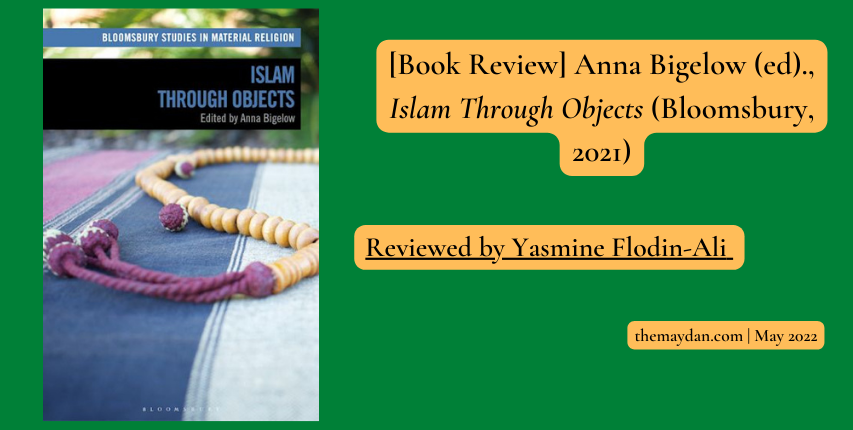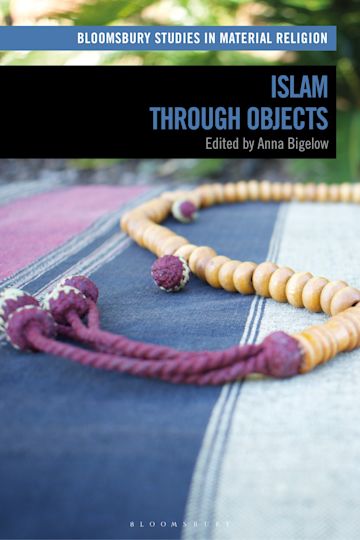
Anna Bigelow, ed. Islam through Objects. New York, NY: Bloomsbury Academic, 2021. 264 pages. $31.45 paperback | Reviewed by Yasmine Flodin-Ali
Islam Through Objects, edited by Anna Bigelow, was published in 2021 as part of the Bloomsbury Studies in Material Religion series. Each chapter of this anthology analyzes a particular object from different period and geography in Islamic history. What is included in the category of “Islamic” and what constitutes an object are reoccurring discussions throughout the anthology, and the chapters themselves vary widely in terms of their focus, approach, and theoretical background. Yet despite the diversity of topics, the book feels fairly cohesive, in large part thanks to Bigelow’s introduction, which gives an excellent summary of current research at the intersection of Islamic Studies and Material Culture. The end result is a collection that is not only an important read for anyone interested in Islamic material culture, but also a wonderful resource for Islamic Studies educators. The book’s focus on tangible objects provides a fresh take on many Islamic Studies topics, ranging from gender in the Nation of Islam to the ecological implications of holy Zamzam water.
The chapters in this anthology are grouped into four subsections: “Tracing Images,” “Identifying Objects,” “Objects in Practice,” and “Circulatory Systems.” Almost all of the chapters could fall under at least two of these headings. Although the wide range of topics make it unlikely that one reader would find all of the chapters equally useful, this same breadth guarantees that there are at least a few chapters relevant to anyone interested in Islamic Studies. Surveyed topics range from depictions of the Prophet Muhammad’s sandals, to the role of tasbih (prayer beads) in West African history, to coins in 14th century Yemen.

The anthology’s introduction, “Thinking With Islamic Things” provides an overview of many of the sources and scholarship with which later chapters engage. Quoting Qur’anic passages, Bigelow dissects the principle of tawhid, radical divine unity between all of creation, and considers the implications of including material objects as a part of that paradigm of unity. She cites classical Islamic philosophers like Ibn Arabi, who wrote on the nature of objects and their sentience in relation to human beings. The introduction also draws upon more contemporary scholarship by Islamic Studies scholars such as Jamal Elias and Shahab Ahmed. In What Is Islam?, Ahmed advocates for a definition of Islam that emphasizes artistic formations over legalist and textualist models, arguing that the objects of everyday life are more relevant to defining Islam as a lived religious tradition. Many of the anthology’s authors agree with and draw upon Ahmed’s material culture-focused framing of the field.
“Authors in the volume repeatedly ask to what extent we are the creators of our built environment, and to what extent objects are capable of exerting their own agency over us.”
Authors in the volume repeatedly ask to what extent we are the creators of our built environment, and to what extent objects are capable of exerting their own agency over us. In the introduction, Bigelow posits that a focus on objects helps us understand that our own bodies are permeable assemblages of “physical matter, sensory experiences, and spiritual sensibilities, situated within sympathetic alliances of pollical, economic, and social structures (9).” Focusing on the porosity of the human form breaks down clear-cut binary categorizations of “object” and “human.” This re-orientation can be as empowering as it unsettling.
Joyce Burkhalter Flueckigger’s chapter “The Agency of the Material Taviz (Amulet) in a South Indian Healing Room,” gets to the heart of the questions raised by the introduction on the agency of objects. Flueckigger notes that when her ethnographic interlocutor, Amma, produces taviz, or healing amulets, her customers accept their agency without considering the “semantic value of what is written on them (133).” Amma can read and write in Arabic, while most of her customers cannot. Amma explains that just as patients do not necessarily understand the components of the medicine they are being prescribed, the words Amna writes have material value outside of their literal meaning, imbuing the objects she produces with power.
“Focusing on the porosity of the human form breaks down clear-cut binary categorizations of ‘object’ and ‘human.’ This re-orientation can be as empowering as it unsettling.”
Three of the anthology’s twelve chapters focus on clothing, another object that is in intimate relation to the human body. In the chapter “‘The Greatest and Only Flag Known:’ The Lapel Pin in American Islam,” author Michael Muhmmad Knight focuses on a flag lapel pin worn by members of the Nation of Islam. Knight draws upon Shahab Ahmed to argue that the pin is an Islamic object. In Kayla Wheeler’s chapter, “Clothes of Righteousness: The MGT Uniform in the Twentieth Century,” she analyzes the Nation of Islam’s dress codes for women, arguing that they performed three functions: reclaiming Black femininity, distinguishing the group as a distinct religious group, and cultivating an ethical self (21). Scott Kugle echoes Wheeler’s emphasis on the representative power of clothes, arguing that fabric is a metaphor for the body (96). In his chapter on the hat worn by the Chishti Sufi order, Kugle posits, “The cap stands for the wearer in a relation of synecdoche (99).” In other words, the cap is a symbol for the head, which is representative of the mindset and point of view of an individual. Here Kugle echoes Jean Baudrillard’s The System of Objects, where Baudrillard argues that the way humans arrange and relate to objects is representative of large power structures.[1]
Several of the chapters trace the way a visual symbol has traveled and taken on new meaning over time. Kugle explains how the fez hat became associated with Islam. As Indian efforts for independence from England ramped up, the Gandhi cap made of homemade cotton became a symbol of resistance for many Hindus. Many Muslims searching for a symbol of anti-colonial resistance identified with the fez. They saw the fez as a symbol of Islamic modernism in Turkey, a modernism that seemed to exist outside of Europe’s overbearing domain (105). Even after the secularist Ataturk banned the fez in Turkey, it remained popular internationally as a symbol of Islamic solidarity and nostalgia. For example, Elijah Muhammad of the Nation of Islam proudly sported a fez (105).
The chapter, “The Masonic Muhammad: Modern Franc-Iranian Visual Encounters in Prophetic Iconography” by Christiane Gruber, takes place in a completely different context than Kugle’s fez example, but illustrates a similar phenomenon. There was a proliferation of images in Iran in the 1980s and 1990s of the Prophet Muhammad as a beardless youth. These images were placed on a variety of objects including postcards, posters, and carpets. This was striking because the Prophet was typically depicted in Iran as an older bearded man in the the prime of his life. Gruber explains that these images were inspired by a popular photograph taken by French orientalists in North Africa of a young boy entitled “Mohamed (32).” In both Kugle and Gruber’s examples, tracing the backstory of a visual reference reveals larger networks of exchange and power.
The last two chapters of the anthology focus on water in two very different contexts. In the second to last chapter, “The Alijibe del Rey in Granada,” D. Fairchild Ruggles traces water as it melts from the snowfall in the Sierra Nevada mountains and travels to Alijibe del Rey in Granada. In the last chapter, “Zamzam Water: Environmentality and Decolonizing Material Islam,” author Anna Gade focuses on a small glass vial of water from the well of Zamzam in Mecca, attached to a necklace. Both pieces ask whether a natural resource such as water can be considered an object. Gade brings together the field of Material Culture with Environmental Studies as she analyzes this object, noting that water is repeatedly mentioned as a sign from God in the Qur’an, and that this gift from God is now a scare resource because of global inequity and climate change (190). Gade’s consideration of how climate change influences our relationship to objects raises questions about how spirituality intersects with the realities of capitalism.
“After journeying through so many diverse examples, a separate conclusion written by Bigelow could give a better sense completion to the readers. “
Concluding the book with Gade’s excellent chapter feels a bit abrupt, though. After journeying through so many diverse examples, a separate conclusion written by Bigelow could give a better sense completion to the readers. Nevertheless, this anthology considers an impressive breadth of issues and incorporates a vast range of geographic and sectarian diversity, no small feat for such a reasonably sized volume. This anthology would serve as a wonderful tool for instructors looking for an innovative way to introduce the diversity of Islamic Studies as a field, and is essential reading for anyone interested in Islamic Studies and Material Culture.
Yasmine Flodin-Ali is an Islamic Studies PhD Candidate in the Religious Studies department at the University of North Carolina at Chapel Hill, where her research focuses on the history of Muslims and race.
*The author first presented this review at the Fifth Annual Graduate Students Book Review Colloquium on Islam and Middle Eastern Studies in 2021 organized by Ali Vural Ak Center for Global Islamic Studies at George Mason University and the Maydan.
[1] Jean Baudrillard, The System of Objects, trans. James Benedict (New York, NY: Verso, 1996), 4.

